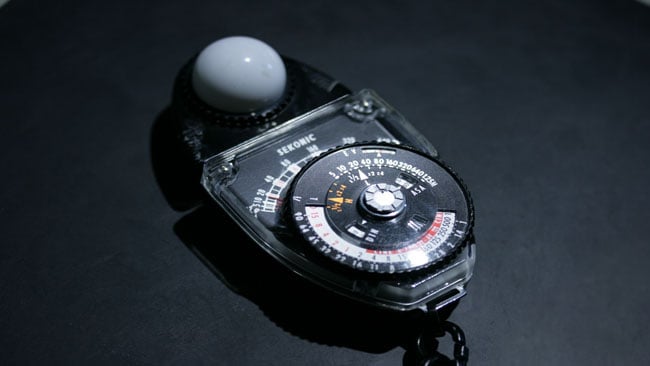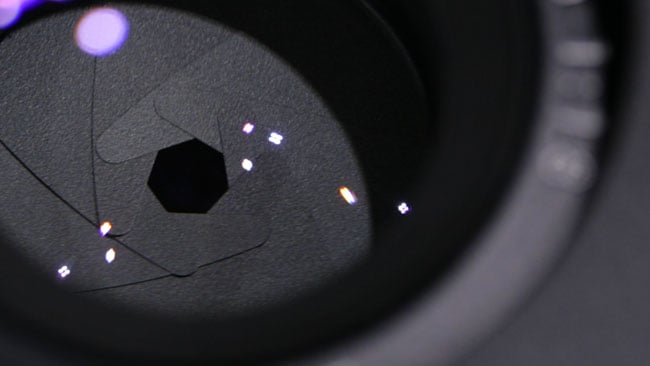Replay: How many photons make 5? Phil Rhodes on the fairly complex mathematical relationship of absolute light levels in lux to photographic exposure setups.
Light is something that humanity has learned to measure quite well. It comes in small chunks (which is where the term “quantum” comes from) and we can calculate how many chunks there are in many common situations. For practical purposes, this is a bit cumbersome – the number of photons emitted by filmmaking lights is very large, and we aren't interested in all of them.
Infrared and ultraviolet radiation are still photons, after all, but they don't affect the exposure when we're using cameras designed to mimic the human eye. Things are further complicated by the combination of settings we use on cameras, which can vary effective sensitivity, shutter speed, and F-stop, plus, of course, photographic intent.

Light meters, such as this classic Sekonic L398, often read light in footcandles. Convert to lux by multiplying by 10.7639, or 10.8 if you're feeling approximate
All of this is why we use the standard-index unit of lux when we're reviewing lighting. Lux (and footcandles, which are not standard index units and equal to a bit less than 0.01 lux) are units of luminous flux.
The key word here is “luminous” - radio waves are invisible and therefore not luminous, and neither is infra-red or ultraviolet energy. Luminosity takes into account the sensitivity of the human eye, and thus, roughly, a camera. Lux is an absolute value and can be related to an exposure value, and therefore to a set of ISO sensitivity, shutter speed and aperture settings.
Usually it's easiest to use a table to do that – really, use a table - but we'll include the calculations here, for completeness. If this isn't of interest, skip to the end, where we'll quickly deal with translating lux to camera settings, or just use an online calculator.

Each successively wider stop on an aperture doubles the amount of light, decreasing exposure value by 1
Exposure values and F-stops
Exposure values themselves are instinctively easy to understand for photographers, because they work the same way as F-stops and shutter speeds, doubling the light every time we decrease the EV by one. Most people understand that an exposure of 1/48s at f/4 – a very typical situation in filmmaking – lets twice the amount of light in as 1/48s at f/5.6, because we've opened up one stop. 1/48s at f/4 therefore has an exposure value one higher than than 1/48s at f/5.6.
Conversely, if we were to open up one stop and double the shutter speed, going from 1/48 at f/5.6 to 1/96 at f/4 – we'd end up with exactly the same amount of light. The picture might not look the same, since we're now operating with what motion picture people would consider a reduced shutter angle and also with reduced depth of field, but the absolute exposure, in the main, would be the same. Therefore, so would the exposure value.
Exposure value 0 corresponds to a one second exposure at f/1.0, an unusual (though not impossible) situation. EV -1 would therefore correspond to a two-second exposure at f/1.0, or, perhaps more realistically, a four-second exposure at f/1.4, which is doable with some fast stills primes.
Mathematically, the EV of a camera setup is the binary logarithm of the aperture squared over the shutter time. The scary bit of this is “binary logarithm”, notated log2 because binary numbers are base 2.
This is easier than it sounds: log2(n) it's the power to which we must raise the number 2 to get n. If n is 16, for instance, the binary logarithm is 4, because two raised to the power four, or 2×2×2×2, is 16. The relationship of this to exposure, where everything halves or doubles with each f-stop or step in shutter speed, is instinctive.
Proper exposure in digital cinematography is highly dependent on lookup tables and other camera settings, and should be evaluated with a waveform monitor
In practice, figuring out the aperture squared over the shutter time is relatively straightforward. For instance, at f/2 and 1/48, the aperture squared is 4, and the shutter time is 1÷48, or roughly 0.0208. Working this out, we get 4÷0.0208=192.
The binary logarithm of 192 is something we pretty much have to use a calculator to do, and it's about 7.58. This agrees with EV charts which give us EV 7 for 1/30 at f/2 and EV 8 for 1/60 at f/2. We'd expect to be between the two with our oddball 1/48 motion-picture shutter speed.
A brief trick: many calculators won't do binary logarithms directly, but the natural logarithm of a number divided by the natural logarithm of 2 is handily equal to the binary logarithm of that number.
Because numbers in photography are often slightly rounded off or adjusted, it doesn't always work out too cleanly even if we work on stills shutter speeds. Let's do 1/60 at f/2, which we calculate as log2(22÷(1/60)). Most charts give EV 8 for this combination. In reality, it works out to 7.907 or so.
The reason for this is that shutter speeds aren't quite perfect one-stop sequences. Usually, cameras offer shutter speeds of 1s, 1/2s, 1/4s, and 1/8s, but then jump to 1/15s, which should really be 1/16 if we expect the exposure time to reduce by half for each step. The shutter speed nearest 1/60 should really be 1/64. Work it out for 1/64, and we find that the aperture squared divided by the shutter speed works out to 4÷(1/64) or 256. As any software engineer knows, the binary logarithm of 256 is exactly 8, since 28 = 256.
The Sekonic C-700R, and most light meters, can give a raw light level reading in lux
Sensor sensitivity
To work out how much light would be required to expose properly at a given EV, we need to know one more thing: the sensitivity of the film or sensor. Relationships between exposure values and raw light levels in lux are often given with the assumption of ISO 100, which is a low sensitivity in modern film and TV practice.
For a reasonable exposure at ISO 100 and a shutter speed and aperture leading to EV 8, about 640 lux is required. This is very much dependent on what “reasonable exposure” means and the mathematics use a meter calibration constant, called C for incident light, which is determined entirely empirically by having a lot of people look at photos and opine on which one is correctly exposed. C is usually around 330, and the exposure value which would be correctly exposed at a given ISO can be calculated: it's the binary logarithm of the light level in lux multiplied by the ISO, divided by C.
So, if we measure – say – 1000 lux and we're shooting at ISO 100, the exposure value is the binary logarithm of 1000×100÷330, or about 303, for an EV of 8.2. Various online calculators (and in fact light meters too) will give answers nearby depending on the value of C they prefer.
Practically speaking, it's worth keeping two main things in mind:
The exposure value of a camera setup is the binary logarithm of the aperture squared over the shutter time in seconds. For 1/48s at f/2.8, calculate log2(2.82÷(1/48)), giving 8.56. On a calculator:
2.8 x2 ÷ (1 ÷ 48) = ln ÷ 2 ln = 8.56...
To achieve proper exposure in light of a given brightness, required exposure value is the binary logarithm of lux multiplied by ISO over 330. For 1000 lux and 100 ISO, calculate log2(1000×100÷330), giving 8.2. On a calculator:
1000 × 100 ÷ 330 = ln / 2 ln = 8.24...
Thus, 1000 lux is just under a third of a stop overexposed at f/2.8 and 1/48s at 100 ISO.
This is why most people carry photo data books with charts for this stuff, and why we give measurements in lux when evaluating lighting – it's easier than giving numbers for every possible camera setup.
tl;dr
- Lux (and footcandles) are units of luminous flux used to measure light levels.
- Exposure values (EV) are used to represent different combinations of aperture and shutter speed settings that result in the same exposure.
- The relationship between aperture, shutter speed, and exposure value is based on the logarithmic scale, where each change represents a doubling or halving of light.
- Calculating exposure values involves using the binary logarithm of the aperture squared over the shutter time, which can be approximated using EV charts or calculators.